Sliding patio doors have become one of the most stylish and functional ways to connect indoor and outdoor spaces. Whether you’re renovating your home or planning a new build, the right door can dramatically change how your living area feels adding light, space, and elegance.
Homeowners love sliding patio doors for their space-saving design, easy operation, and ability to bring natural light indoors. Unlike swinging doors, they glide smoothly on tracks, making them perfect for small patios or modern open-concept spaces.
When I installed mine, I immediately noticed how the room felt larger and brighter. The visual connection to the garden alone was worth it.

There are three main styles of sliding doors, each offering a unique look and function.
This is the most common type: one fixed panel and one sliding panel.
In my case, I started with a standard 2-panel model. It was cost-effective and easy to install, ideal for smaller patios.
This elegant option uses three or more panels that stack neatly when opened, creating a wide, panoramic view.
Pros: Blends indoor and outdoor areas beautifully, ideal for entertaining.
Cons: More expensive and complex to install.
When I tried a stacking model in a friend’s new build, the seamless transition between the kitchen and terrace was stunning. It truly felt like one continuous space.
Here, one or more panels slide into a pocket inside the wall, disappearing completely.
Pros: Provides a full, unobstructed opening and a clean, minimalist look.
Cons: Requires wall reconstruction—best for new homes or major remodels.
I’ve always admired pocket doors for their architectural beauty. They’re a bold investment but transform any room into a sleek, modern space.
The material of your patio door affects durability, insulation, and aesthetics:
| Material | Advantages | Ideal For |
|---|---|---|
| Vinyl | Affordable, low maintenance, energy efficient | Most homes and budgets |
| Aluminum | Strong, modern look, narrow frames | Contemporary or coastal homes |
| Wood | Warm, classic appearance | Traditional or rustic designs |
Look for double glazing, Low-E glass, and ENERGY STAR ratings. Efficient doors reduce heat transfer and save on energy bills.
Quality locks, reinforced frames, and toughened glass make a big difference. Regular cleaning of tracks ensures smooth operation.
Installation cost depends on door type and wall structure. Pocket and multi-panel systems require professional help, while 2-panel doors can sometimes be DIY-installed if you’re handy.
When I renovated my patio, I compared all three styles. The 2-panel was easy and affordable, but the stacking system truly opened up my living space. For anyone who loves entertaining, that design creates the perfect indoor-outdoor flow.
It depends on your budget and space. Standard 2-panel doors are cost-effective, while multi-panel and pocket doors offer a premium experience.
Yes, modern doors with Low-E glass and insulated frames can be extremely efficient.
Prices range from $800 for basic models to $6,000+ for large multi-panel or pocket systems.
Vinyl for low maintenance, aluminum for modern style, and wood for timeless warmth.



Palm Beach County
Boca Raton, Highland Beach, Delray Beach, Boynton Beach, West Palm Beach, Jupiter, Palm Beach Gardens, Wellington, Palm Springs, Greenacres, Juno Beach Florida
Broward County
Parkland, Pompano Beach, Coral Springs, Coconut Creek, Margate, Deerfield Beach
Are you looking for sliding door repair services? If your sliding door is giving you the trouble we can help.
Perfect Sliding Doors has been in the sliding door business for over 12 years. We know our sliding doors inside and out, and we’ll make sure your sliding door operates smoothly.
Perfect Sliding Doors offers a wide range of sliding door installation and repair services. We’ll help you find the perfect sliding door for your home and provide the best installation and repair services around.
Sliding Doors, and Sliding Door Related Products. We offer the best sliding doors, sliding door installation, and sliding door repair services.